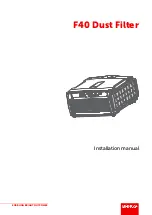
A — NFPA minimum of 4", maximum 1/2 of the Listed
spacing that the sprinkler was calculated for.
D — Distance to opposing sloped ceiling.
F & G — Acceptable for angles 0
°
to 60
°
.
Figure 13 - Obstruction to Discharge by Intersecting Flat Ceiling
If “D” is “Obstructed” per Figure 13 Graph, then “D” is to be
considered the area of coverage and additional sprinklers
along the horizontal ceiling will be necessary. Only if “D” is
“Acceptable” can “A” be considered 1/2 of the maximum
Listed spacing that the sprinkler was calculated for. Dimen-
sion “A” is measured along the slope.
A — Maximum 1/2 of the Listed spacing that the sprinkler
was calculated for.
D — Distance to intersecting horizontal ceiling.
F — Acceptable for angles 0
°
to 60
°
.
Figure 14 - Obstruction to Discharge by an Opposing Sloped Ceiling
If “D” is “Obstructed” per Figure 14 Graph, then the
horizontal distance to the opposing slope is the extent of
coverage and additional sprinklers will be necessary to
protect the remainder of the opposing slope. Only if “D” is
“Acceptable” can “A” equal 1/2 of the maximum Listed
spacing that the sprinkler was calculated for. Dimension “A”
is measured along the slope.
D
F
A
0
°
4
°
8
°
12
°
16
°
20
°
24
°
28
°
32
°
36
°
40
°
44
°
48
°
52
°
56
°
60
°
10'
9'
8'
6'
5'
4'
3'
2'
1'
7'
"D"
(in feet)
"F"
(in degrees)
Obstructed
Acceptable
20' x 20'
18' x 18'
16' x 16'
14' x 14'
12' x 12'
A
D
A
G
F
5'
4'
3'
2'
1'
"D"
(in feet)
"F" or "G"
(whichever is greater)
(in degrees)
Obstructed
10
°
15
°
20
°
25
°
30
°
35
°
40
°
45
°
Acceptable
20' x 20'
18' x 18'
16' x 16'
14' x 14'
12' x 12'
The Central Model BVR-2 must be maintained and serviced
in accordance with the following instructions:
NOTES
Wet pipe sprinkler systems must be maintained at a
minimum temperature of 40
°
F/4
°
C to prevent freezing
and bursting of the pipe and/or sprinklers.
Automatic sprinklers are not to be tested with a heat
source. Operation of the heat responsive element (bulb)
can result.
Absence of an Escutcheon Plate may delay the time to
sprinkler operation in a fire situation.
Before closing a fire protection system main control
valve for maintenance work on the fire protection
system which it controls, permission to shut down the
affected fire protection system must be obtained from
the proper authorities and all personnel who may be
affected by this action must be notified.
Care &
Maintenance
Do NOT enclose sprinklers within drapes, curtains, or
valances.
Do NOT hang anything from the sprinklers.
Do NOT cleanse the sprinklers with soap and water,
detergents, ammonia, cleaning fluids, or other chemi-
cals. Remove dust, lint, cobwebs, cocoons, insects, and
larvae by gently brushing with a feather duster or gently
vacuuming with a soft bristle (i.e., dusting) brush
attachment.
Exercise suitable safety precautions in the use and
storage of highly flammable materials. The rapid rate of
fire development and spread of which can be caused by
such materials can reduce the ability of the sprinkler
system to aid in the control of a fire in which they are
involved.
Sprinklers which are found to be leaking or exhibiting
visible signs of corrosion must be replaced.
Automatic sprinklers must never be shipped or stored
where its temperature will exceed 100
°
F/38
°
C and they
must never be painted, plated, coated, or otherwise
altered after leaving the factory. Modified sprinklers must
be replaced. Sprinklers that have been exposed to
corrosive products of combustion, but have not operated,
OBSOLETE


























